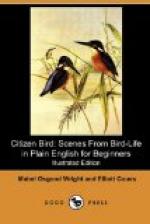“How can the little Ducks get down to the ground—do their wings grow strong very soon?” asked Nat.
“You have seen that most birds come from the egg quite naked, and stay in the nest till their feathers grow, like Canaries and all other song birds, while others are hatched all covered with down, the same as Chickens are. The young of those living in open exposed places, such as sea and shore birds, are thickly clothed with down when hatched. Such downy plumage is not exactly like the feathers that sprout after a while, but it answers the same purpose; for the little things could not run about or swim if they were naked, you know.”
“Yes, Ducklings are all downy; for I remember those that came out in June up at the Farm were, and their tiny little wings were as cunning and cute as could be,” said Dodo.
[Illustration: Wood Duck.]
“When little Wood Ducks are hatched and become quite dry, their mother takes them in her beak, by the wing, one by one, and flies down to the ground with them. As soon as her brood of ten or a dozen is thus collected, she leads them off to the nearest water, and the whole lot of Ducklings go in swimming, bobbing for food as if they were a year old instead of only a few hours. Then mamma begins to drill them in danger-signalling, so that at the slightest hint from her they dive and swim out of harm’s way.
“Sea Ducks do not always live on the ocean, as the name would lead you to expect, but prefer large open waters, either fresh like those of lakes, or salt, as in bays and sounds. They eat both animal and vegetable food, oftentimes diving deeply, and swimming far under water to find it. Of course they, in common with all other Ducks, must take a vast amount of mud and water into their mouths with their food; but instead of having to swallow this, it drains off through the little grooves on the inside edges of the bill, as a ship’s deck is drained of water by means of the scuppers. But that I have explained to you already. Some Sea Ducks are more plentiful than their river brethren; and as they spend both their days and nights offshore, they run less danger of extermination. Most of them nest also in the far North, in much the same fashion as River Ducks do.
“Two celebrated members of this group are the Redhead and the Canvasback, who are always welcome guests at dinner, and are so much alike in the crisp brown company dress they wear on the table, with plenty of stuffing and gravy, that very few persons can tell them apart. But the most famous one of all is the Eider Duck—the one which yields such an abundance of exquisitely soft, warm down that we use it for making the best sort of bedquilts.”




